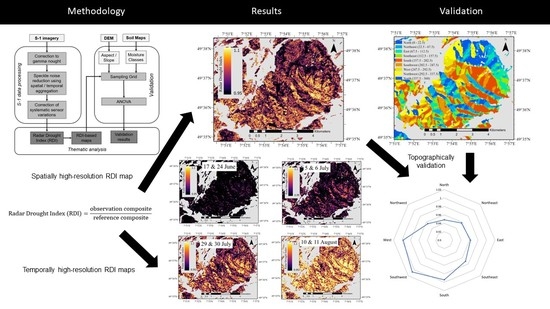Potential of Sentinel-1 Data for Spatially and Temporally High-Resolution Detection of Drought Affected Forest Stands
Abstract
:1. Introduction
2. Materials and Methods
2.1. Study Area and Period of Investigation
2.2. Data
2.2.1. Sentinel-1
2.2.2. Sentinel-2
2.2.3. Digital Elevation Model
2.2.4. Forest Mask
2.2.5. Soil Moisture Classes
2.3. Radar Drought Index
2.3.1. S-1 Data Processing
2.3.2. Thematic Analysis
2.3.3. Validation
3. Results
3.1. Speckle Noise Reduction
3.2. Radar Drought Index
3.3. Comparison to Soil Moisture Classes and Topographic Indices
4. Discussion
5. Conclusions
Author Contributions
Funding
Institutional Review Board Statement
Informed Consent Statement
Data Availability Statement
Acknowledgments
Conflicts of Interest
References
- Braun, S.; de Witte, L.C.; Hopf, S.E. Auswirkungen des Trockensommers 2018 auf Flächen der Interkantonalen Walddauerbeobachtung. Schweiz. Z. Forstwes. 2020, 171, 270–280. [Google Scholar] [CrossRef]
- Schuldt, B.; Buras, A.; Arend, M.; Vitasse, Y.; Beierkuhnlein, C.; Damm, A.; Gharun, M.; Grams, T.E.E.; Hauck, M.; Hajek, P.; et al. A first assessment of the impact of the extreme 2018 summer drought on Central European forests. Basic Appl. Ecol. 2020, 45, 86–103. [Google Scholar] [CrossRef]
- Tyukavina, A.; Potapov, P.; Hansen, M.C.; Pickens, A.H.; Stehman, S.V.; Turubanova, S.; Parker, D.; Zalles, V.; Lima, A.; Kommareddy, I.; et al. Global Trends of Forest Loss Due to Fire From 2001 to 2019. Front. Remote Sens. 2022, 3, 825190. [Google Scholar] [CrossRef]
- NASA FIRMS. VIIRS Fires Alerts. Available online: www.globalforestwatch.org (accessed on 27 June 2022).
- Hill, J.; Stoffels, J.; Buddenbaum, H.; Schröck, H.-W.; Langshausen, J. Die Nutzung des Sentinel-2-Datenarchivs zur Zeitnahen Bewertung des Vitalitätszustands von Nadel-Holzbeständen im Bundesland Rheinland-Pfalz als Folge des Trockenen Spätsommers; 2. Symposium zur Angewandten Satellitenerdbeobachtung: Neue Perspektiven der Erdbeobachtung., Cologna. 2019. Available online: https://www.dialogplattform-erdbeobachtung.de/downloads/praesentationen2019/9_Session_5/Session_5b/2_Hill.pdf (accessed on 12 July 2021).
- Dotzler, S.; Hill, J.; Buddenbaum, H.; Stoffels, J. The Potential of EnMAP and Sentinel-2 Data for Detecting Drought Stress Phenomena in Deciduous Forest Communities. Remote Sens. 2015, 7, 14227–14258. [Google Scholar] [CrossRef] [Green Version]
- Baltensweiler, A.; Brun, P.; Pranga, J.; Psomas, A.; Zimmermann, N.E.; Ginzler, C. Räumliche Analyse von Trockenheitssymptomen im Schweizer Wald mit Sentinel-2-Satellitendaten. Schweiz. Z. Fur Forstwes. 2020, 171, 298–309. [Google Scholar] [CrossRef]
- Sudmanns, M.; Tiede, D.; Augustin, H.; Lang, S. Assessing global Sentinel-2 coverage dynamics and data availability for operational Earth observation (EO) applications using the EO-Compass. Int. J. Digit. Earth 2019, 13, 768–784. [Google Scholar] [CrossRef] [Green Version]
- Dobson, M.C.; Pierce, L.; Sarabandi, K.; Ulaby, F.T.; Sharik, T. Preliminary Analysis of ERS-1 SAR for Forest Ecosystem Studies. IEEE Trans. Geosci. Remote 1992, 30, 203–211. [Google Scholar] [CrossRef]
- Konings, A.G.; Rao, K.; Steele-Dunne, S.C. Macro to micro: Microwave remote sensing of plant water content for physiology and ecology. New Phytol. 2019, 223, 1166–1172. [Google Scholar] [CrossRef] [Green Version]
- Marpaung, F.; Putiamini, S.; Fernando, D.; Dinanta, G.P.; Sumirah; Nugroho, D. Estimation of Dielectric Constant Using A Dual-pol Sentinel-1A in Tropical Peatland. IOP Conf. Ser. Earth Environ. Sci. 2019, 280, 012030. [Google Scholar] [CrossRef]
- Luckman, A. A study of the relationship between radar backscatter and regenerating tropical forest biomass for spaceborne SAR instruments. Remote Sens. Environ. 1997, 60, 1–13. [Google Scholar] [CrossRef]
- Laurin, G.V.; Balling, J.; Corona, P.; Mattioli, W.; Papale, D.; Puletti, N.; Rizzo, M.; Truckenbrodt, J.; Urban, M. Above-ground biomass prediction by Sentinel-1 multitemporal data in central Italy with integration of ALOS2 and Sentinel-2 data. J. Appl. Rem. Sens. 2018, 12, 1. [Google Scholar] [CrossRef]
- Navarro, J.A.; Algeet, N.; Fernández-Landa, A.; Esteban, J.; Rodríguez-Noriega, P.; Guillén-Climent, M.L. Integration of UAV, Sentinel-1, and Sentinel-2 Data for Mangrove Plantation Aboveground Biomass Monitoring in Senegal. Remote Sens. 2019, 11, 77. [Google Scholar] [CrossRef] [Green Version]
- Argamosa, R.J.L.; Blanco, A.C.; Baloloy, A.B.; Candido, C.G.; Dumalag, J.B.L.C.; Dimapilis, L.C.; Paringit, E.C. Modelling above ground biomass of mangrove forest using Sentinel-1 imagery. ISPRS Ann. Photogramm. Remote Sens. Spat. Inf. Sci. 2018, IV-3, 13–20. [Google Scholar] [CrossRef] [Green Version]
- Huang, X.; Ziniti, B.; Torbick, N.; Ducey, M.J. Assessment of Forest above Ground Biomass Estimation Using Multi-Temporal C-band Sentinel-1 and Polarimetric L-band PALSAR-2 Data. Remote Sens. 2018, 10, 1424. [Google Scholar] [CrossRef] [Green Version]
- Nasirzadehdizaji, R.; Balik Sanli, F.; Abdikan, S.; Cakir, Z.; Sekertekin, A.; Ustuner, M. Sensitivity Analysis of Multi-Temporal Sentinel-1 SAR Parameters to Crop Height and Canopy Coverage. Appl. Sci. 2019, 9, 655. [Google Scholar] [CrossRef] [Green Version]
- Vreugdenhil, M.; Wagner, W.; Bauer-Marschallinger, B.; Pfeil, I.; Teubner, L.; Rüdiger, C.; Strauss, P. Sensitivity of Sentinel-1 Backscatter to Vegetation Dynamics: An Austrian Case Study. Remote Sens. 2018, 10, 1396. [Google Scholar] [CrossRef] [Green Version]
- Hansen, J.N.; Mitchard, E.T.A.; King, S. Assessing Forest/Non-Forest Separability Using Sentinel-1 C-Band Synthetic Aperture Radar. Remote Sens. 2020, 12, 1899. [Google Scholar] [CrossRef]
- Rüetschi, M.; Schaepman, M.E.; Small, D. Using Multitemporal Sentinel-1 C-band Backscatter to Monitor Phenology and Classify Deciduous and Coniferous Forests in Northern Switzerland. Remote Sens. 2017, 10, 55. [Google Scholar] [CrossRef] [Green Version]
- Frison, P.-L.; Fruneau, B.; Kmiha, S.; Soudani, K.; Dufrene, E.; Le Toan, T.; Koleck, T.; Villard, L.; Mougin, E.; Rudant, J.-P. Potential of Sentinel-1 Data for Monitoring Temperate Mixed Forest Phenology. Remote Sens. 2018, 10, 2049. [Google Scholar] [CrossRef] [Green Version]
- Rüetschi, M.; Small, D.; Waser, L.T. Rapid Detection of Windthrows Using Sentinel-1 C-Band SAR Data. Remote Sens. 2019, 11, 115. [Google Scholar] [CrossRef]
- Abdel-Hamid, A.; Dubovyk, O.; Graw, V.; Greve, K. Assessing the impact of drought stress on grasslands using multi-temporal SAR data of Sentinel-1: A case study in Eastern Cape, South Africa. Eur. J. Remote Sens. 2020, 53, 3–16. [Google Scholar] [CrossRef]
- Shorachi, M.; Kumar, V.; Steele-Dunne, S.C. Sentinel-1 SAR Backscatter Response to Agricultural Drought in The Netherlands. Remote Sens. 2022, 14, 2435. [Google Scholar] [CrossRef]
- Urban, M.; Berger, C.; Mudau, T.; Heckel, K.; Truckenbrodt, J.; Onyango Odipo, V.; Smit, I.; Schmullius, C. Surface Moisture and Vegetation Cover Analysis for Drought Monitoring in the Southern Kruger National Park Using Sentinel-1, Sentinel-2, and Landsat-8. Remote Sens. 2018, 10, 1482. [Google Scholar] [CrossRef] [Green Version]
- Lee, D.; Kim, J.; Lee, M.H.; Lee, S.B.; Kim, J. Application of Landsat −8 and Sentinel-L Images for Drought Monitoring Over the Korean Peninsula. In Proceedings of the IGARSS 2018 IEEE International Geoscience and Remote Sensing Symposium, Valencia, Spain, 22–27 July 2018; pp. 7286–7288. [Google Scholar] [CrossRef]
- Kim, W.; Jeong, J.; Choi, M. Evaluation of Reservoir Monitoring-based Hydrological Drought Index Using Sentinel-1 SAR Waterbody Detection Technique. Korean J. Remote Sens. 2022, 38, 153–166. [Google Scholar] [CrossRef]
- Lopez-Martinez, C.; Fabregas, X. Polarimetric sar speckle noise model. IEEE Trans. Geosci. Remote Sens. 2003, 41, 2232–2242. [Google Scholar] [CrossRef] [Green Version]
- Ministerium für Umwelt, Landwirtschaft, Ernährung, Weinbau und Forsten/Landesforsten Rheinland-Pfalz. Der Wald In Rheinland-Pfalz Ergebnisse der Bundeswaldinventur 3. Available online: https://mulewf.rlp.de/uploads/media/Der_Wald_in_Rheinland-Pfalz_-_Ergebnisse_der_Bundeswaldinventur_3_10.10.2014.pdf (accessed on 10 November 2021).
- KWIS RLP. Entwicklung der Temperatur im Kalenderjahr (Jan-Dez) im Naturraum Pfälzerwald Haardtgebierge) im Zeitraum 1881 bis 2021. Available online: https://www.kwis-rlp.de/uploads/tx_userdownload/Zeitreihe-1y_air-temp-mean_kalJahr_Naturraum-Haardtgebirge_Bezug-erste-202203151411.png (accessed on 29 April 2022).
- Rauthe, M.; Steiner, H.; Riediger, U.; Mazurkiewicz, A.; Gratzki, A. A Central European precipitation climatology—Part I: Generation and validation of a high-resolution gridded daily data set (HYRAS). metz 2013, 22, 235–256. [Google Scholar] [CrossRef]
- KWIS RLP. Entwicklung der Temperatur im Kalenderjahr (Jan-Dez) im Bundesland Rheinland-Pfalz im Zeitraum 1881 bis 2021. Available online: https://www.kwis-rlp.de/uploads/tx_userdownload/Zeitreihe-1y_air-temp-mean_kalJahr_Bundesland-Rheinland-Pfalz_Bezug-erste-202203151411.png (accessed on 29 April 2022).
- KWIS RLP. Entwicklung des Niederschlags im Kalenderjahr (Jan-Dez) im Bundesland Rheinland-Pfalz im Zeitraum 1881 bis 2021. Available online: https://www.kwis-rlp.de/uploads/tx_userdownload/Zeitreihe-1y_precipitation_kalJahr_Bundesland-Rheinland-Pfalz_Bezug-erste-202203151413.png (accessed on 29 April 2022).
- Torres, R.; Snoeij, P.; Geudtner, D.; Bibby, D.; Davidson, M.; Attema, E.; Potin, P.; Rommen, B.; Floury, N.; Brown, M.; et al. GMES Sentinel-1 mission. Remote Sens. Environ. 2012, 120, 9–24. [Google Scholar] [CrossRef]
- Konings, A.G.; Saatchi, S.S.; Frankenberg, C.; Keller, M.; Leshyk, V.; Anderegg, W.R.L.; Humphrey, V.; Matheny, A.M.; Trugman, A.; Sack, L.; et al. Detecting forest response to droughts with global observations of vegetation water content. Glob. Chang. Biol. 2021, 27, 6005–6024. [Google Scholar] [CrossRef]
- Ulaby, F.T.; Dubois, P.C.; van Zyl, J. Radar mapping of surface soil moisture. J. Hydrol. 1996, 184, 57–84. [Google Scholar] [CrossRef]
- Molijn, R.; Iannini, L.; Vieira Rocha, J.; Hanssen, R. Sugarcane Productivity Mapping through C-Band and L-Band SAR and Optical Satellite Imagery. Remote Sens. 2019, 11, 1109. [Google Scholar] [CrossRef] [Green Version]
- Park, S.-E. Variations of Microwave Scattering Properties by Seasonal Freeze/Thaw Transition in the Permafrost Active Layer Observed by ALOS PALSAR Polarimetric Data. Remote Sens. 2015, 7, 17135–17148. [Google Scholar] [CrossRef] [Green Version]
- Bartels, H.; Weigl, E.; Reich, T.; Lang, P.; Wagner, A.; Kohler, O.; Gerlach, N. Projekt RADOLAN: Routineverfahren zur Online-Aneichung der Radarniederschlagsdaten mit Hilfe von Automatischen Bodenniederschlagsstationen (Ombrometer). 2004. Available online: https://www.dwd.de/DE/leistungen/radolan/radolan_info/abschlussbericht_pdf.pdf?__blob=publicationFile&v=2 (accessed on 15 October 2022).
- Winterrath, T.; Rosenow, W.; Weigl, E. On the DWD quantitative precipitation analysis and nowcasting system for real-time application in German flood risk management. IAHS-AISH Publ. 2012, 351, 323–329. [Google Scholar]
- AM RLP. Agrarmeteorologie Rheinland-Pfalz: Waldklimastation Dannenfels. Available online: https://www.am.rlp.de/Agrarmeteorologie/Wetterdaten/Pfalz (accessed on 12 December 2021).
- Frantz, D.; Haß, E.; Uhl, A.; Stoffels, J.; Hill, J. Improvement of the Fmask algorithm for Sentinel-2 images: Separating clouds from bright surfaces based on parallax effects. Remote Sens. Environ. 2018, 215, 471–481. [Google Scholar] [CrossRef]
- Frantz, D.; Röder, A.; Stellmes, M.; Hill, J. An Operational Radiometric Landsat Preprocessing Framework for Large-Area Time Series Applications. IEEE Trans. Geosci. Remote Sens. 2016, 54, 3928–3943. [Google Scholar] [CrossRef]
- Frantz, D.; Röder, A.; Udelhoven, T.; Schmidt, M. Enhancing the Detectability of Clouds and Their Shadows in Multitemporal Dryland Landsat Imagery: Extending Fmask. IEEE Geosci. Remote Sens. Lett. 2015, 12, 1242–1246. [Google Scholar] [CrossRef]
- Frantz, D. FORCE—Landsat + Sentinel-2 Analysis Ready Data and Beyond. Remote Sens. 2019, 11, 1124. [Google Scholar] [CrossRef] [Green Version]
- European Environment Agency. European Digital Elevation Model (EU-DEM): Version 1.0. Available online: http://land.copernicus.eu/pan-european/satellite-derived-products/eu-dem/eu-dem-v1-0-and-derived-products/eu-dem-v1.0/view (accessed on 15 October 2022).
- Mouratidis, A.; Ampatzidis, D. European Digital Elevation Model Validation against Extensive Global Navigation Satellite Systems Data and Comparison with SRTM DEM and ASTER GDEM in Central Macedonia (Greece). IJGI 2019, 8, 108. [Google Scholar] [CrossRef] [Green Version]
- European Environment Agency. Corine Land Cover (CLC) 2018: Version 2020_20u1. Available online: https://land.copernicus.eu/pan-european/corine-land-cover/clc2018 (accessed on 15 October 2022).
- Gauer, J.; Feger, K.-H.; Schwärzel, K. Measurement and assessment of water dynamics of forest sites within the framework of forest site mapping: Current conditions and future requirements. Wald. Landsch. Und Nat. 2011, 12, 7–16. [Google Scholar]
- Zuhlke, M.; Fomferra, N.; Brockmann, C.; Peters, M.; Veci, L.; Malik, J.; Regner, P. SNAP (Sentinel Application Platform) and the ESA Sentinel 3 Toolbox. Sentin.-3 Sci. Workshop 2015, 734, 21. [Google Scholar]
- Filipponi, F. Sentinel-1 GRD Preprocessing Workflow. Proceedings 2019, 18, 11. [Google Scholar] [CrossRef] [Green Version]
- Small, D. Flattening Gamma: Radiometric Terrain Correction for SAR Imagery. IEEE Trans. Geosci. Remote 2011, 49, 3081–3093. [Google Scholar] [CrossRef]
- Laur, H.; Bally, P.; Meadows, P.; Sanchez, J.; Schaettler Lopinto, E.; Esteban, D. ERS SAR Calibration: Derivation of the Backscattering Coefficient σ0 in ESA ERS SAR PRI Products. 05 November 2004. Available online: https://earth.esa.int/eogateway/documents/20142/37627/ERS-SAR-Calibration-Issue2.f_05_DLFE-643.pdf (accessed on 23 September 2022).
- Lee, J.S. Digital image enhancement and noise filtering by use of local statistics. IEEE Trans. Pattern Anal. Mach. Intell. 1980, 2, 165–168. [Google Scholar] [CrossRef]
- Lopes, A.; Touzi, R.; Nezry, E. Adaptive speckle filters and scene heterogeneity. IEEE Trans. Geosci. Remote Sens. 1990, 28, 992–1000. [Google Scholar] [CrossRef]
- Shi, Z.; Fung, K.B. A Comparison of Digital Speckle Filters. In Proceedings of the IGARSS’94, Pasadena, CA, USA, 8–12 August 1994; pp. 2129–2133. [Google Scholar]
- Hansford, D.J.; Jin, Y.; Elston, S.J.; Morris, S.M. Enhancing laser speckle reduction by decreasing the pitch of a chiral nematic liquid crystal diffuser. Sci. Rep. 2021, 11, 4818. [Google Scholar] [CrossRef] [PubMed]
- Schaufler, S.; Bauer-Marschallinger, B.; Hochstöger, S.; Wagner, W. Modelling and correcting azimuthal anisotropy in Sentinel-1 backscatter data. Remote Sens. Lett. 2018, 9, 799–808. [Google Scholar] [CrossRef]
- Tanase, M.A.; Villard, L.; Pitar, D.; Apostol, B.; Petrila, M.; Chivulescu, S.; Leca, S.; Borlaf-Mena, I.; Pascu, I.S.; Dobre, A.C.; et al. Synthetic aperture radar sensitivity to forest changes: A simulations-based study for the Romanian forests. Sci. Total Environ. 2019, 689, 1104–1114. [Google Scholar] [CrossRef] [PubMed]
- Widhalm, B.; Bartsch, A.; Goler, R. Simplified Normalization of C-Band Synthetic Aperture Radar Data for Terrestrial Applications in High Latitude Environments. Remote Sens. 2018, 10, 551. [Google Scholar] [CrossRef] [Green Version]
- Cisneros Vaca, C.R.; van der Tol, C. Sensitivity of Sentinel-1 to Rain Stores in Temperate Forest. In Proceedings of the IGARSS 2018 IEEE International Geoscience and Remote Sensing Symposium, Valencia, Spain, 22–27 July 2018. [Google Scholar] [CrossRef]
- El Hajj, M.; Baghdadi, N.; Zribi, M.; Angelliaume, S. Analysis of Sentinel-1 Radiometric Stability and Quality for Land Surface Applications. Remote Sens. 2016, 8, 406. [Google Scholar] [CrossRef] [Green Version]
- Molijn, R.A.; Iannini, L.; Dekker, P.L.; Magalhaes, P.S.G.; Hanssen, R.F. Vegetation Characterization through the Use of Precipitation-Affected SAR Signals. Remote Sens. 2018, 10, 1647. [Google Scholar] [CrossRef] [Green Version]
- Gitelson, A.A.; Viña, A.; Arkebauer, T.J.; Rundquist, D.C.; Keydan, G.; Leavitt, B. Remote estimation of leaf area index and green leaf biomass in maize canopies. Geophys. Res. Lett. 2003, 30, 1248. [Google Scholar] [CrossRef]
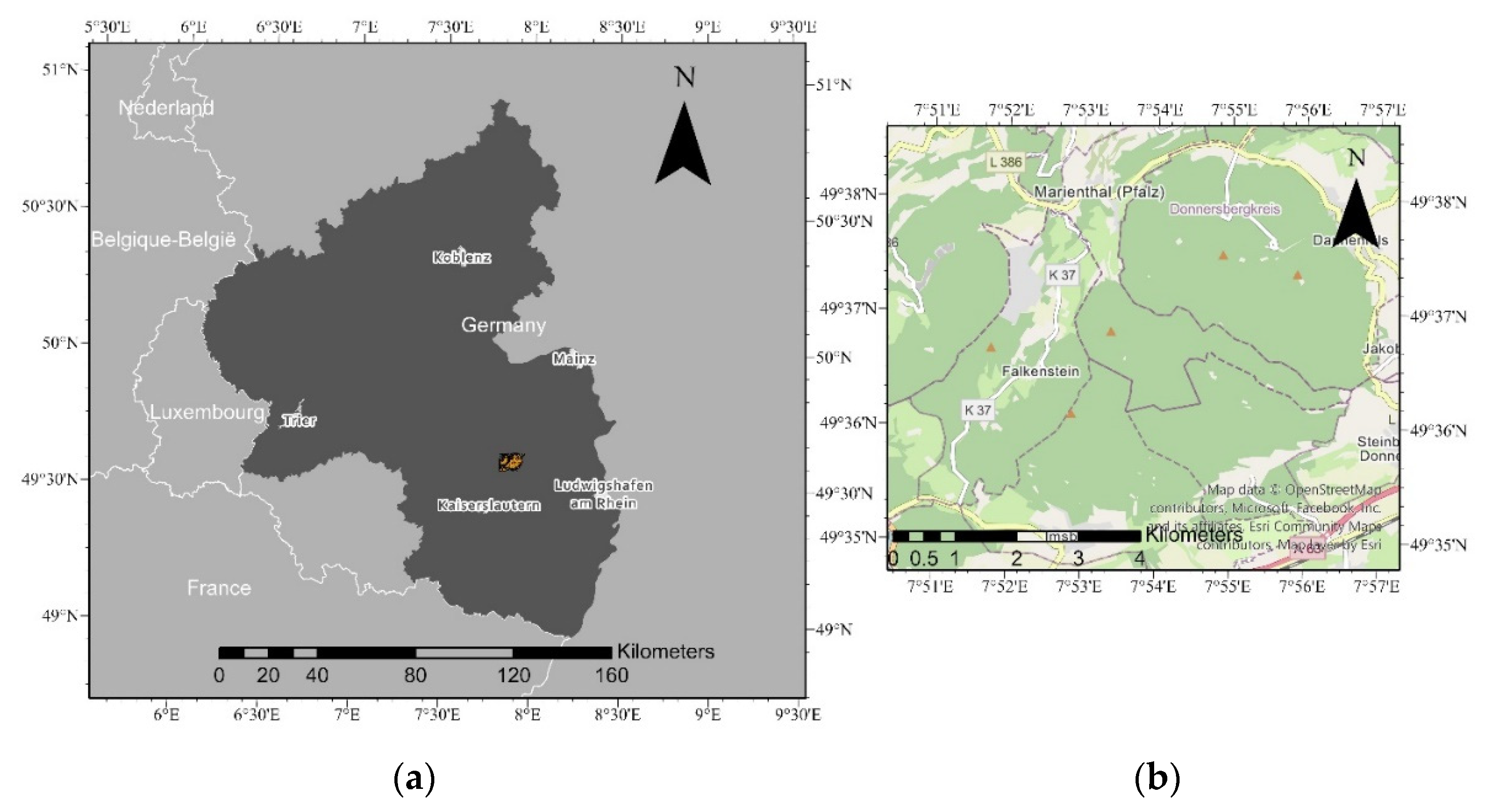

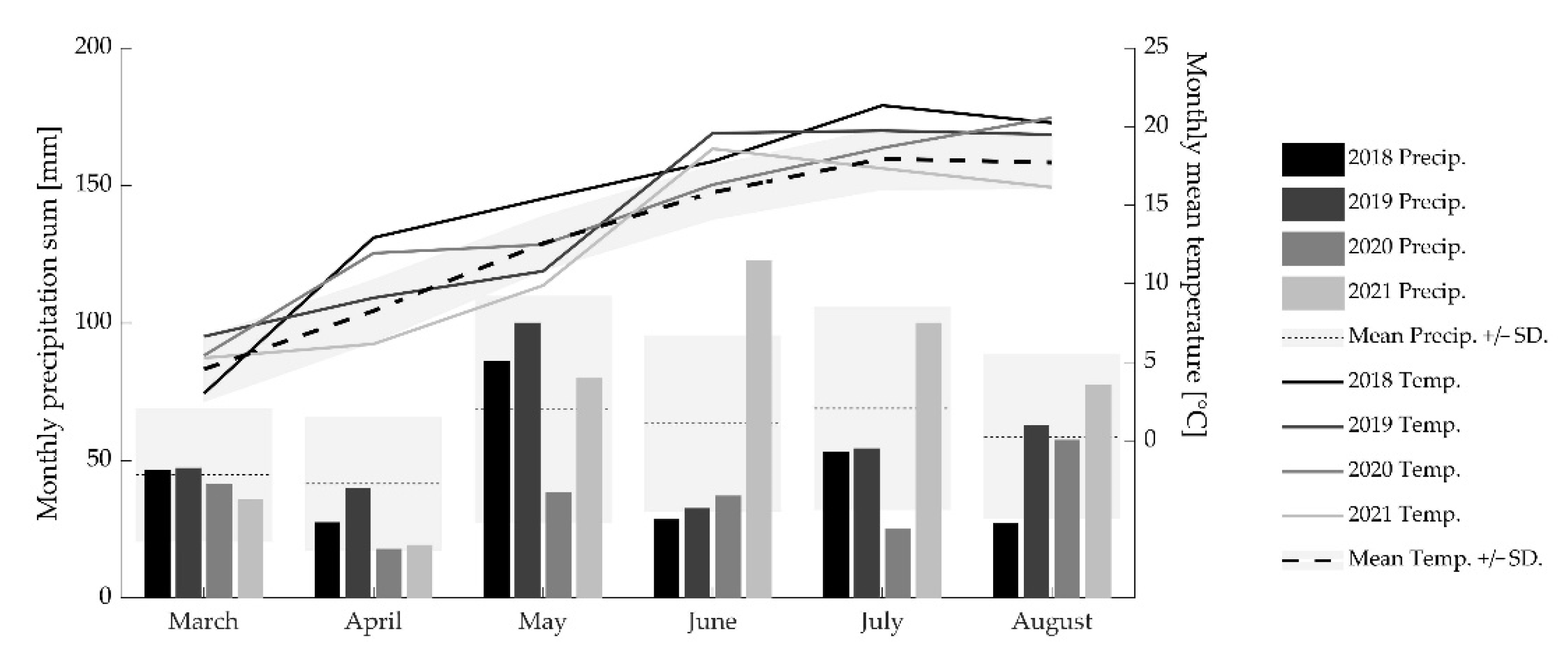

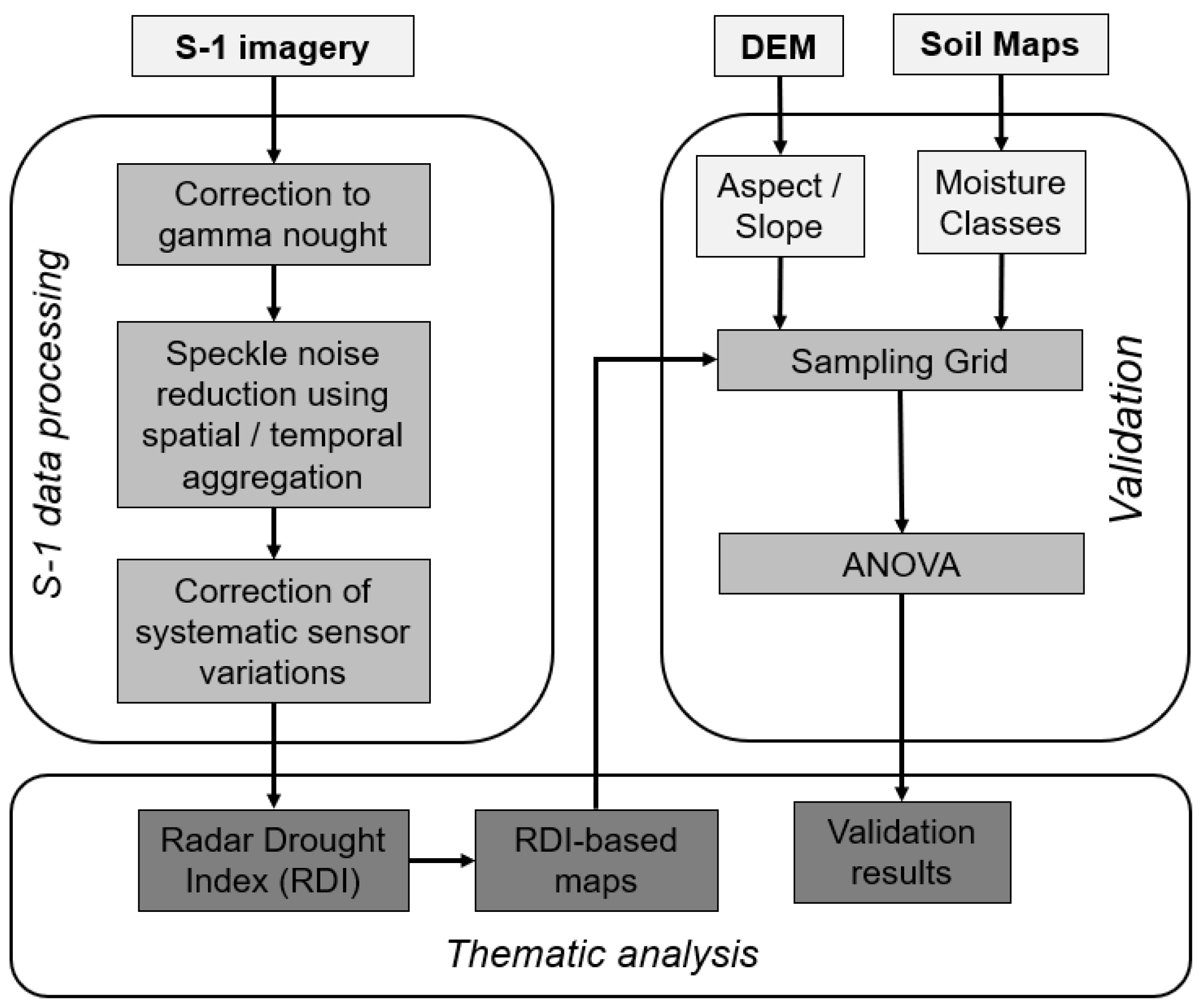

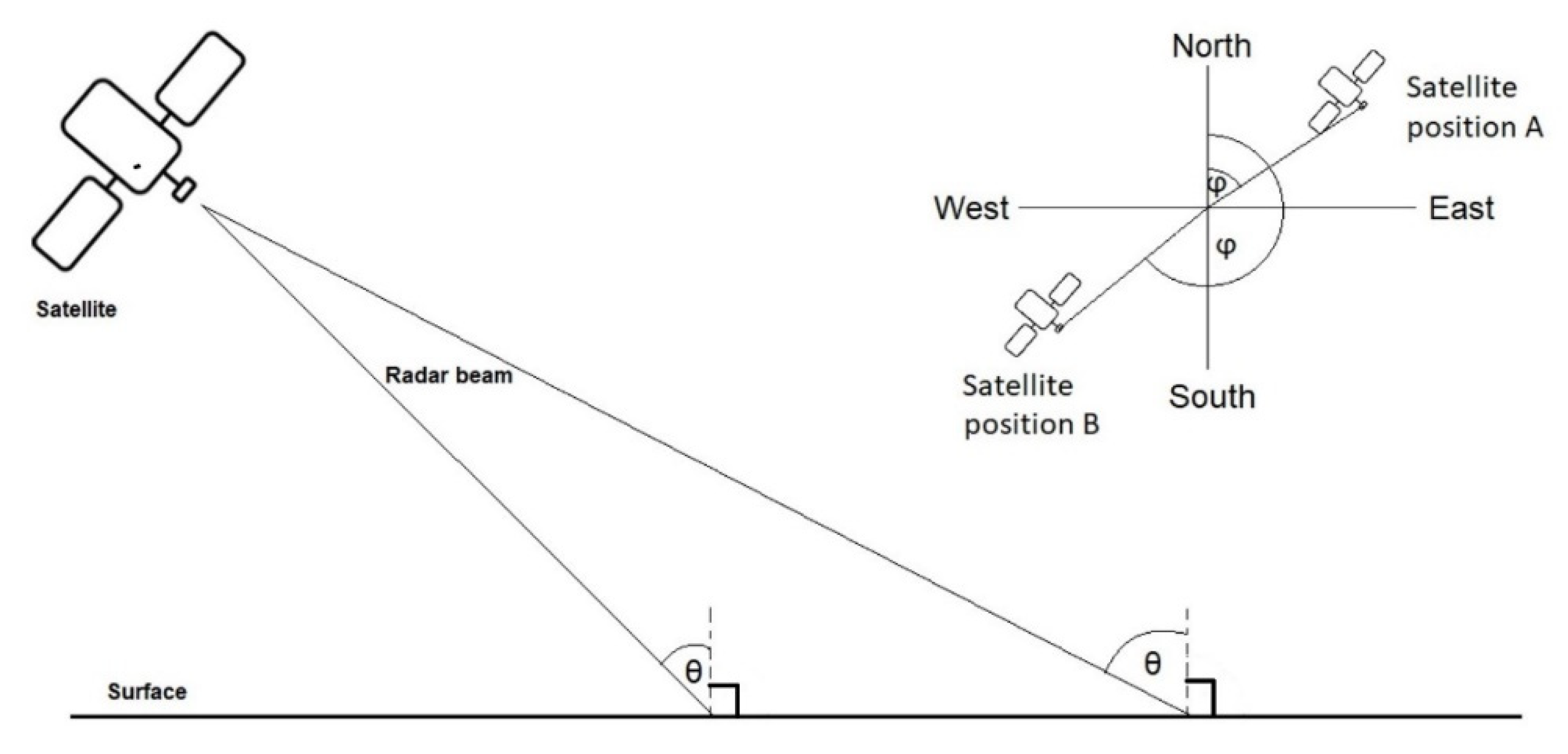
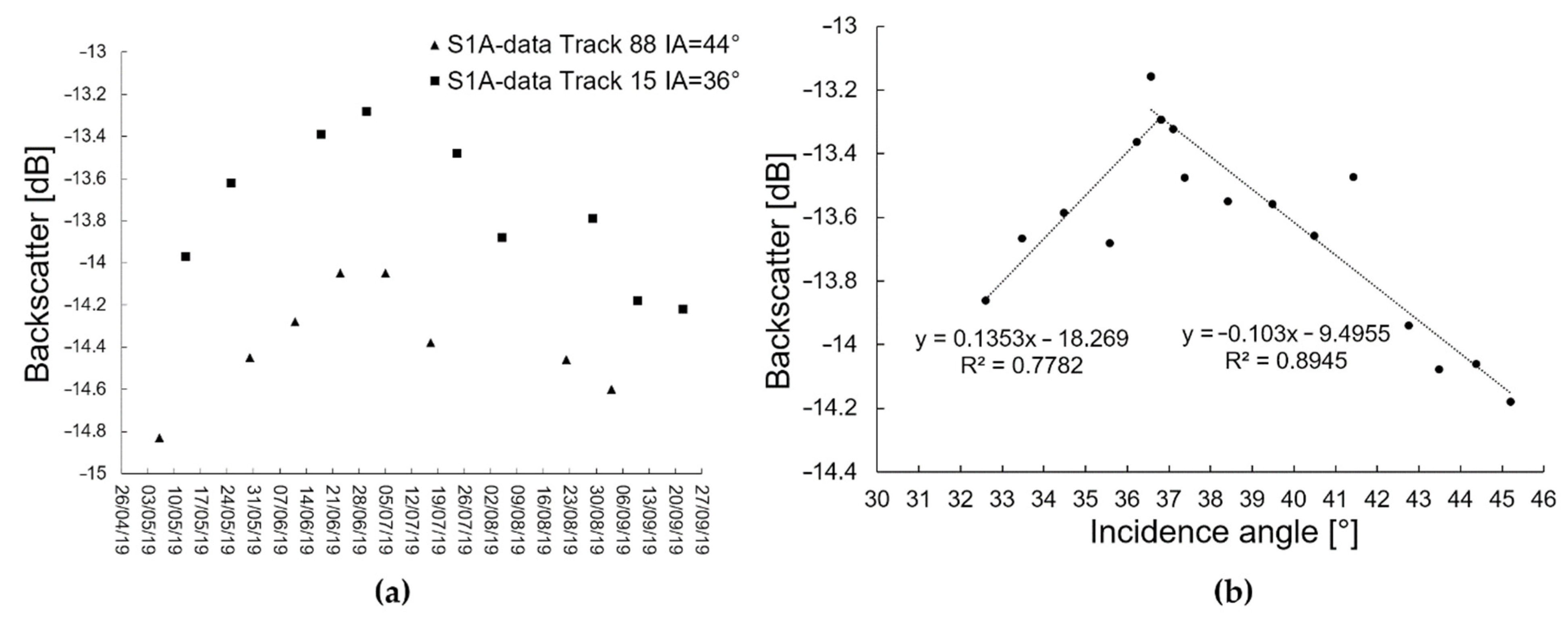

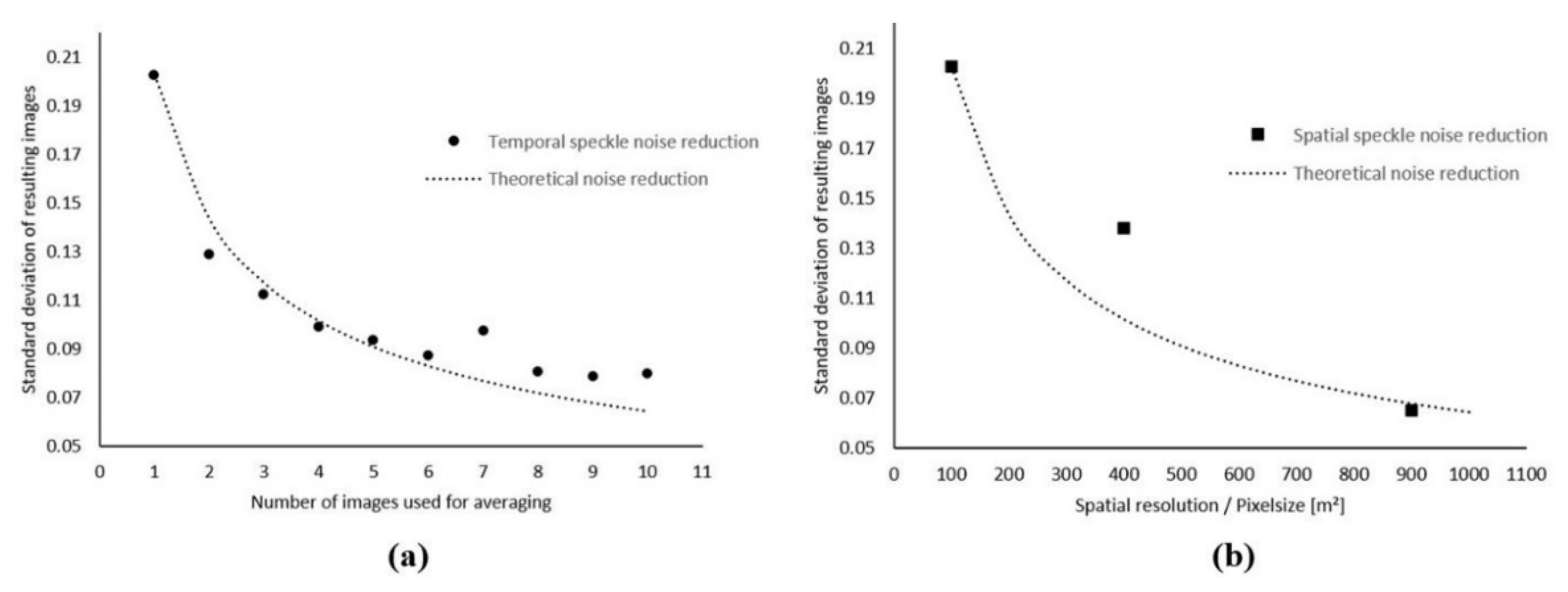
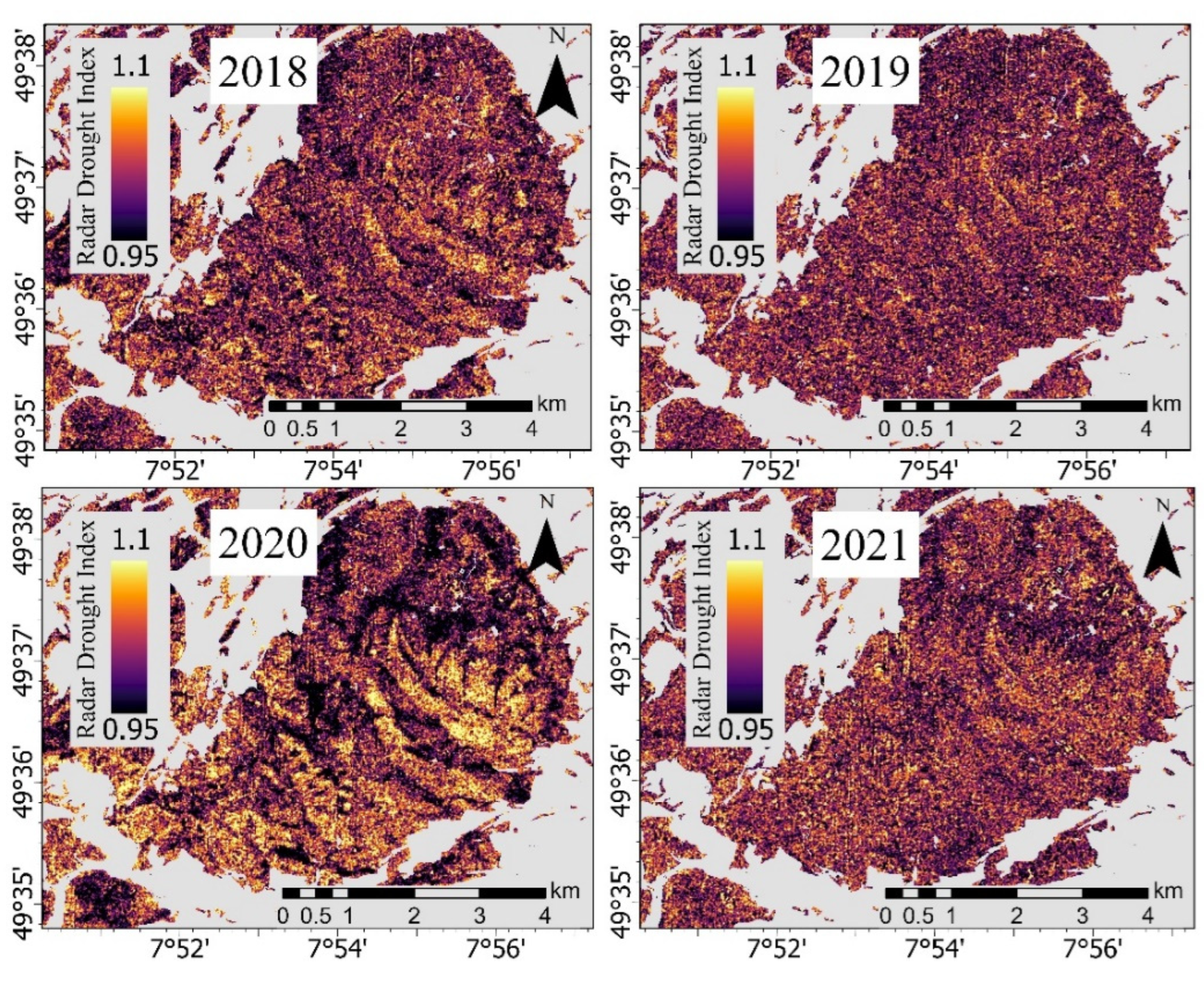

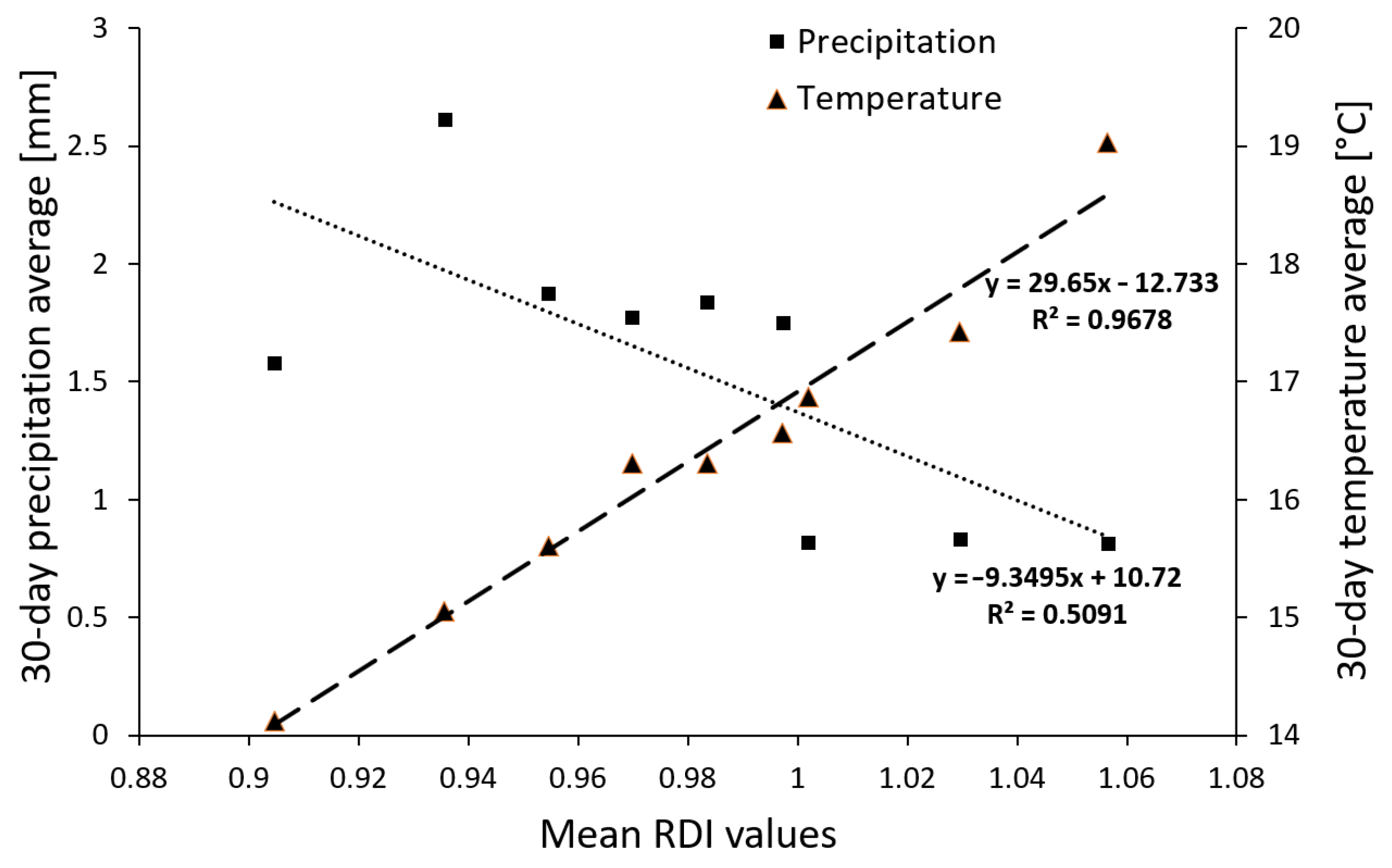
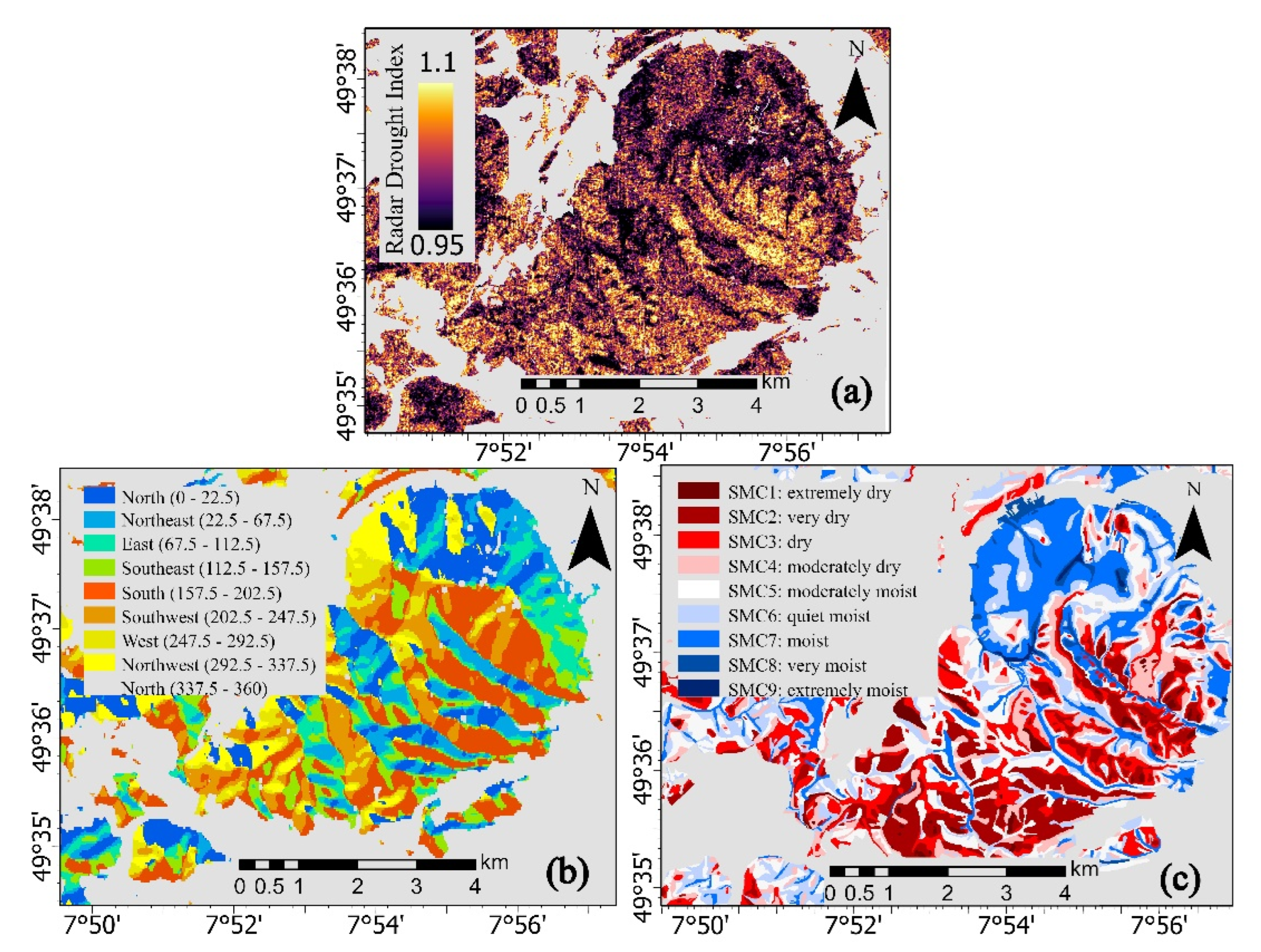
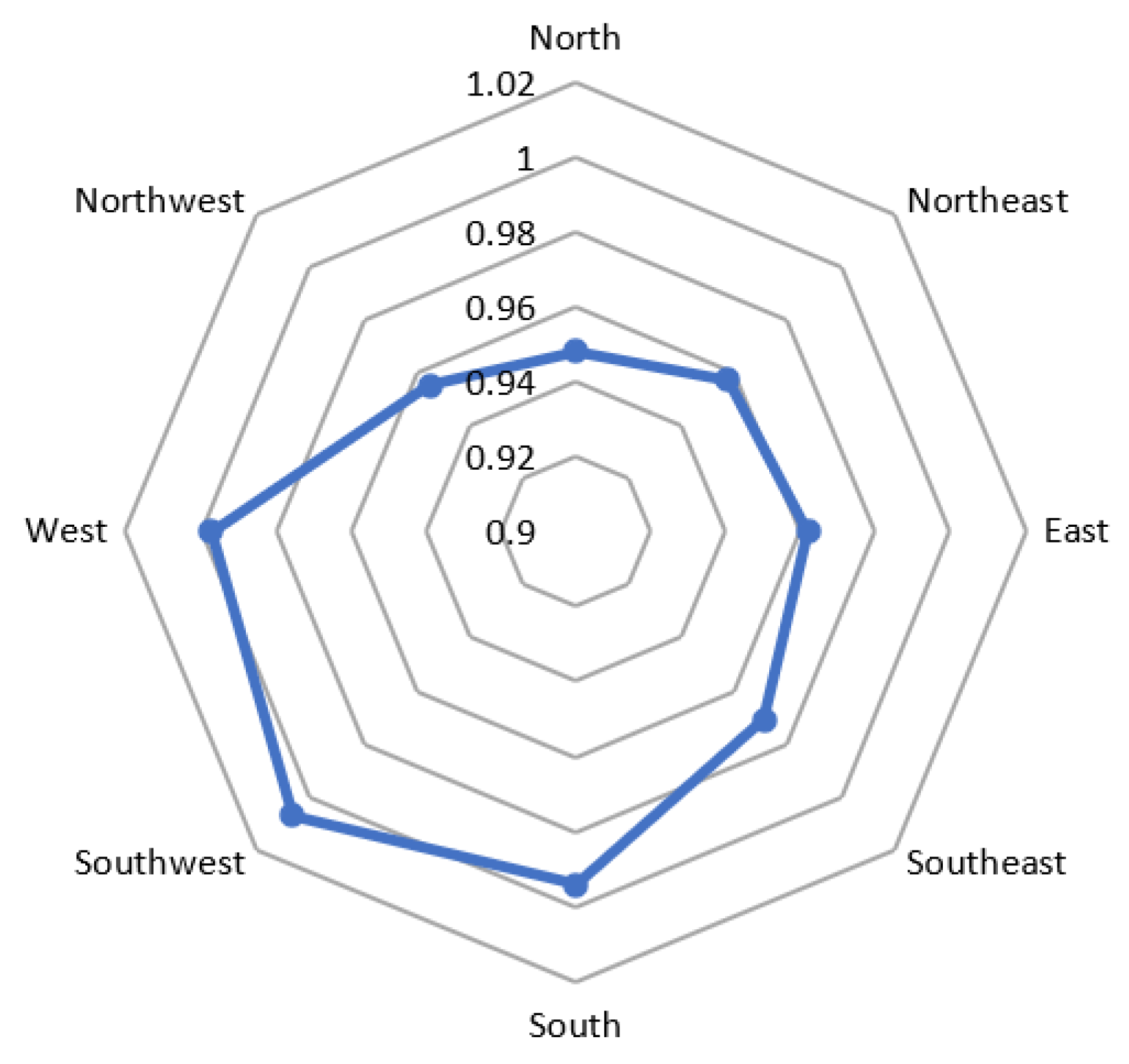
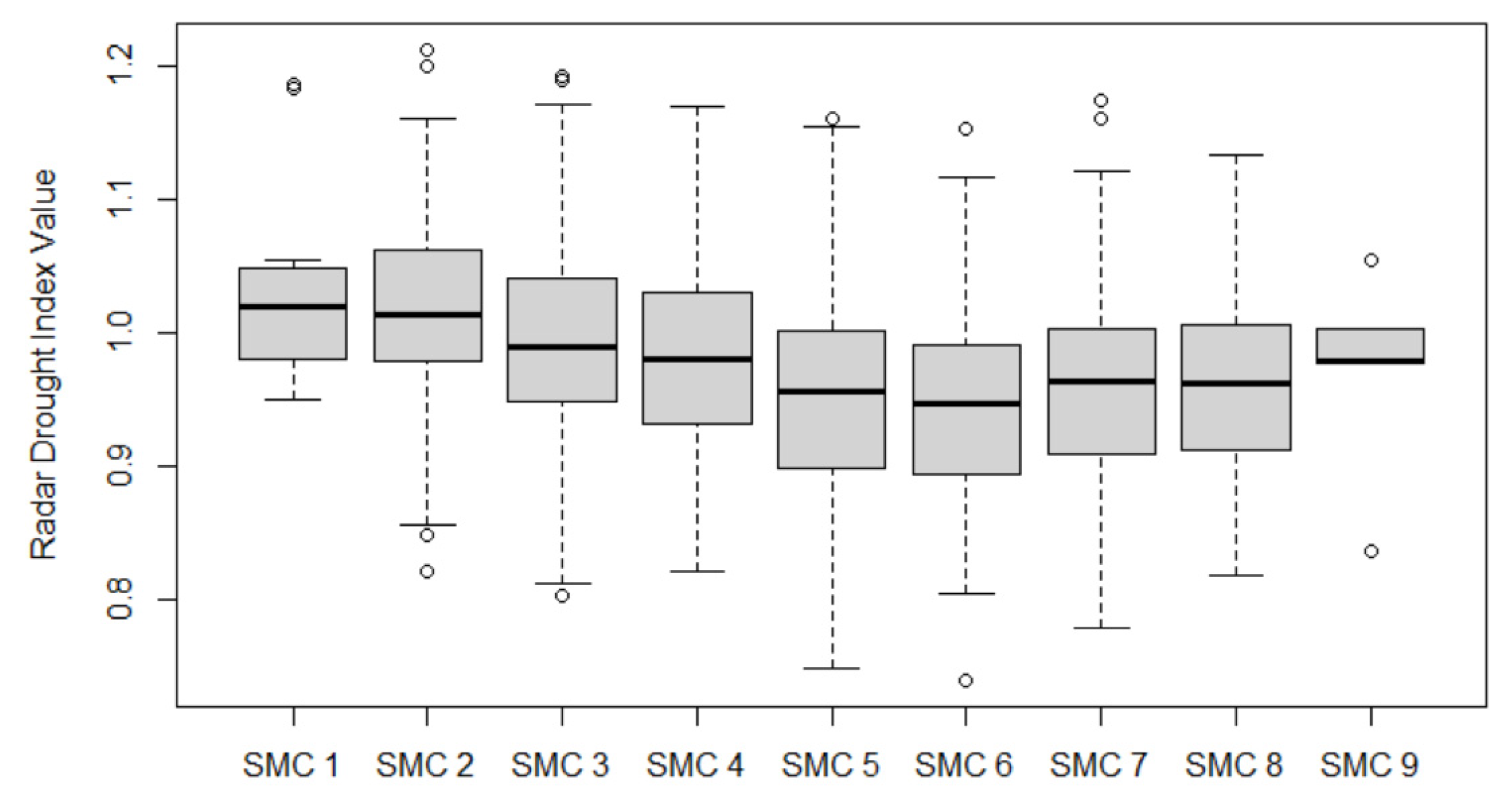
| Overall Goal | Composite | Period | Selected S-1 Images | |
|---|---|---|---|---|
| Spatially high-resolution RDI map | Reference composite | Spring 2019 | S1A Dates (rel. Orbit 15): | 2019-05-01 | 2019-05-13 | |
| 2019-05-25 | 2019-06-18 | ||||
| S1A Dates (rel. Orbit 88): | 2019-05-06 | 2019-05-18 | | |||
| 2019-05-30 | 2019-06-23 | ||||
| S1B Dates (rel. Orbit 15): | 2019-05-07 | 2019-05-19 | | |||
| 2019-05-31 | 2019-06-12 | ||||
| S1B Dates (rel. Orbit 88): | 2019-04-30 | 2019-05-12 | | |||
| 2019-05-24 | 2019-06-17 | ||||
| Observation composites | Summer 2018 | S1A Dates (rel. Orbit 15): | 2018-07-29 | 2018-08-22 | |
| S1A Dates (rel. Orbit 88): | 2018-07-10 | 2018-08-15 | |||
| S1B Dates (rel. Orbit 15): | 2018-07-11 | 2018-08-16 | |||
| S1B Dates (rel. Orbit 88): | 2018-07-28 | 2018-08-21 | |||
| Summer 2019 | S1A Dates (rel. Orbit 15): | 2019-07-24 | 2019-08-29 | ||
| S1A Dates (rel. Orbit 88): | 2019-07-17 | 2019-08-22 | |||
| S1B Dates (rel. Orbit 15): | 2019-07-18 | 2019-07-30 | |||
| S1B Dates (rel. Orbit 88): | 2019-07-23 | 2019-08-28 | |||
| Summer 2020 | S1A Dates (rel. Orbit 15): | 2020-07-30 | 2020-08-11 | ||
| S1A Dates (rel. Orbit 88): | 2020-07-23 | 2020-08-04 | |||
| S1B Dates (rel. Orbit 15): | 2020-07-24 | 2020-08-05 | |||
| S1B Dates (rel. Orbit 88): | 2020-07-29 | 2020-08-10 | |||
| Summer 2021 | S1A Dates (rel. Orbit 15): | 2021-07-25 | 2021-08-06 | ||
| S1A Dates (rel. Orbit 88): | 2021-07-30 | 2021-08-11 | |||
| S1B Dates (rel. Orbit 15): | 2021-07-31 | 2021-08-12 | |||
| S1B Dates (rel. Orbit 88): | 2021-07-24 | 2021-08-05 | |||
| Temporally high-resolution RDI map | Reference composites | Spring 2019 | S1A Dates (rel. Orbit 15): | 2019-05-01 | 2019-05-13 | |
| 2019-05-25 | 2019-06-18 | ||||
| S1A Dates(rel. Orbit 88): | 2019-05-06 | 2019-05-18 | | |||
| 2019-05-30 | 2019-06-23 | ||||
| S1B Dates (rel. Orbit 15): | 2019-05-07 | 2019-05-19 | | |||
| 2019-05-31 | 2019-06-12 | ||||
| S1B Dates (rel. Orbit 88): | 2019-04-30 | 2019-05-12 | | |||
| 2019-05-24 | 2019-06-17 | ||||
| Observation composites (pairs) | Summer 2020 | Pairs (1 × rel. Orbit 88 & 1 × rel. Orbit 15) 2020-06-17 & 2020-06-24 | 2020-06-29 & 2020-06-30 | 2020-07-05 & 2020-07-06 | 2020-07-11 & 2020-07-12 | 2020-07-17 & 2020-07-18 | 2020-07-23 & 2020-07-24 | 2020-07-29 & 2020-07-30 | 2020-08-04 & 2020-08-05 | 2020-08-10 & 2020-08-11 | ||
| North | Northeast | East | Southeast | South | Southwest | West | Northwest | |
|---|---|---|---|---|---|---|---|---|
| North | x | 0.009 | 0.014 | 0.023 | 0.046 *** | 0.059 *** | 0.049 *** | 0.007 |
| Northeast | 0.93 | x | 0.004 | 0.014 | 0.037 *** | 0.052 *** | 0.040 *** | 0.002 |
| East | 0.70 | 0.99 | x | 0.009 | 0.032 ** | 0.045 *** | 0.035 ** | 0.007 |
| Southeast | 0.06 | 0.72 | 0.97 | x | 0.023 * | 0.036 *** | 0.026 | 0.016 |
| South | <0.001 | <0.001 | 0.001 | 0.03 | x | 0.013 | 0.003 | 0.040 *** |
| Southwest | <0.001 | <0.001 | <0.001 | <0.001 | 0.62 | x | 0.009 | 0.052 *** |
| West | <0.001 | <0.001 | 0.007 | 0.09 | 0.99 | 0.96 | x | 0.042 *** |
| Northwest | 0.99 | 0.99 | 0.99 | 0.54 | <0.001 | <0.001 | <0.001 | x |
| SMC 1 | SMC 2 | SMC 3 | SMC 4 | SMC 5 | SMC 6 | SMC 7 | SMC 8 | SMC 9 | |
|---|---|---|---|---|---|---|---|---|---|
| SMC 1 | x | 0.017 | 0.041 | 0.054 | 0.081 ** | 0.088 *** | 0.076 ** | 0.068 | 0.064 |
| SMC 2 | 0.99 | x | 0.024 | 0.037 *** | 0.064 *** | 0.071 *** | 0.059 *** | 0.051 | 0.047 |
| SMC 3 | 0.61 | 0.051 | x | 0.012 | 0.039 *** | 0.047 *** | 0.035 *** | 0.027 | 0.023 |
| SMC 4 | 0.25 | <0.001 | 0.86 | x | 0.027 ** | 0.034 *** | 0.022 | 0.015 | 0.010 |
| SMC 5 | 0.004 | <0.001 | <0.001 | 0.01 | x | 0.007 | 0.005 | 0.013 | 0.017 |
| SMC 6 | 0.001 | <0.001 | <0.001 | <0.001 | 0.97 | x | 0.012 | 0.020 | 0.024 |
| SMC 7 | 0.01 | <0.001 | <0.001 | 0.17 | 0.99 | 0.82 | x | 0.008 | 0.012 |
| SMC 8 | 0.18 | 0.055 | 0.79 | 0.99 | 0.99 | 0.96 | 0.99 | x | 0.004 |
| SMC 9 | 0.77 | 0.88 | 0.99 | 0.97 | 0.99 | 0.99 | 0.99 | 0.99 | x |
Publisher’s Note: MDPI stays neutral with regard to jurisdictional claims in published maps and institutional affiliations. |
© 2022 by the authors. Licensee MDPI, Basel, Switzerland. This article is an open access article distributed under the terms and conditions of the Creative Commons Attribution (CC BY) license (https://creativecommons.org/licenses/by/4.0/).
Share and Cite
Kaiser, P.; Buddenbaum, H.; Nink, S.; Hill, J. Potential of Sentinel-1 Data for Spatially and Temporally High-Resolution Detection of Drought Affected Forest Stands. Forests 2022, 13, 2148. https://doi.org/10.3390/f13122148
Kaiser P, Buddenbaum H, Nink S, Hill J. Potential of Sentinel-1 Data for Spatially and Temporally High-Resolution Detection of Drought Affected Forest Stands. Forests. 2022; 13(12):2148. https://doi.org/10.3390/f13122148
Chicago/Turabian StyleKaiser, Philipp, Henning Buddenbaum, Sascha Nink, and Joachim Hill. 2022. "Potential of Sentinel-1 Data for Spatially and Temporally High-Resolution Detection of Drought Affected Forest Stands" Forests 13, no. 12: 2148. https://doi.org/10.3390/f13122148






